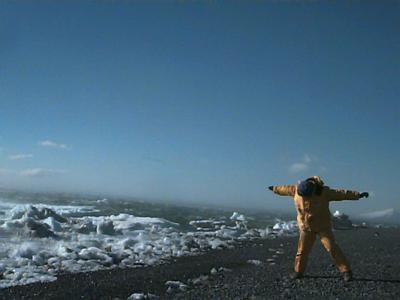
|
|
21 January, 2000
The past two days have been extremely windy here at Cape Bird. The
first hint that it was getting rough outside was the spray blowing off
of the tops of the waves offshore. This occurs when the wind speed is
greater than 35 knots. As we watched from the hut, a large wooden box
full of some of our gear started tumbling like tumbleweed down the
beach. It looked like an empty cardboard box from a distance, but
actually it was four feet long and weighted nearly 100 lbs. We didn't
want to lose it into the sea, so we quickly got dressed and ran down to
secure it. Once on the beach, I realized how strong the winds were. We
had to lean hard and run into the wind to make headway. After getting
the box to safety, we played around in the wind, flapping our arms
trying to fly. Gusts blew volcanic grit into everything open: mouths,
eyes, ears, pockets, etc. The penguins didn't seem too perturbed by all
the wind. They continued their trips into the sea or slept on the
beach. They did have some trouble walking into the wind, but they
persevered, leaning forward about 30 degrees like a nordic ski jumper.
When traveling downwind, the penguins continued to pick up speed,
running faster and faster, until they tripped and tumbled onto their
belly into a toboggan position. This was hilarious to watch. Later, I
took the anemometer out to measure the wind speed and found it to be a
consistent 45 knots with gusts to 50 knots.
Despite the wind, the sky was clear and the sun shinning. Had there
been snow on the ground as on the ice sheet where we did our survival
school, this would have been a full on white out or ≥Herbie≤.
The reason winds can be such a problem in Antarctica is due to the
geography. The strongest winds come from the polar plateau. This type
of wind is known as a katabatic wind. The cold air on the plateau drops
from the 10 000 foot elevation when there is low pressure over the sea.
When the wind drops, it follows the glacial valleys that cut through the
transantarctic mountains. The katabatic wind is the strongest on Earth,
reaching speeds near 200 mph.

Another windy day at Cape Bird. Leigh battling the forces of nature.
Contact the TEA in the field at
.
If you cannot connect through your browser, copy the
TEA's e-mail address in the "To:" line of
your favorite e-mail package.
|
